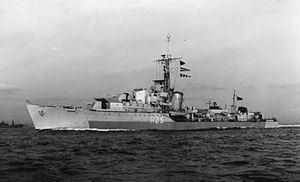
| |
| History | |
|---|---|
| Name | HMS Carysfort |
| Builder | J. Samuel White & Co, Cowes |
| Laid down | 12 May 1943 |
| Launched | 25 July 1944 |
| Commissioned | 10 February 1945 |
| In service | March 1945 |
| Out of service | February 1969 |
| Motto | Manus haec inimica tyrannis : ‘This hand is deadly to tyrants’ |
| Fate | Sold for scrap to BISCO on 23 October 1970 and broken up by J Cashmore. She arrived in tow at the breakers yard in Newport on 15 November 1970. |
| Badge | On a Field Red, out of a ducal coronet gold, an ostrich head Silver in his beak a key Gold. |
| General characteristics | |
| Class and type | C-class destroyer |
| Displacement | |
| Length | 362.75 ft (110.57 m) o/a |
| Beam | 35.75 ft (10.90 m) |
| Draught | 10 ft (3.0 m) |
| Propulsion |
|
| Speed | 36 kn (67 km/h) / 32 kn (59 km/h) full |
| Range |
|
| Complement | 186 (222 as leader) |
| Sensors and processing systems |
|
| Armament |
|
HMS Carysfort was a C-class destroyer of the Royal Navy. She was ordered in 1941, originally under the name HMS Pique.
Her name was changed to conform with the initials "Ca" to her seven sister ships. She is named after John Proby, a politician who was also a Lord of the Admiralty in 1750. In 1752 he was created Baron Carysfort. His son, William Proby, Lord Proby, and his grandson, Granville Proby, 3rd Earl of Carysfort, were both naval officers, the latter eventually became an Admiral. She was the fifth Royal Navy warship to carry the name Carysfort. She was built and engined by J. Samuel White & Co. The keel was to be laid down on 4 May 1943 but was delayed until 12 May 1943 because of German bombing raids. She was launched on 25 July 1944 and completed on 20 February 1945. Her original pennant number was R25 changing to D25 after the Second World War.[1]